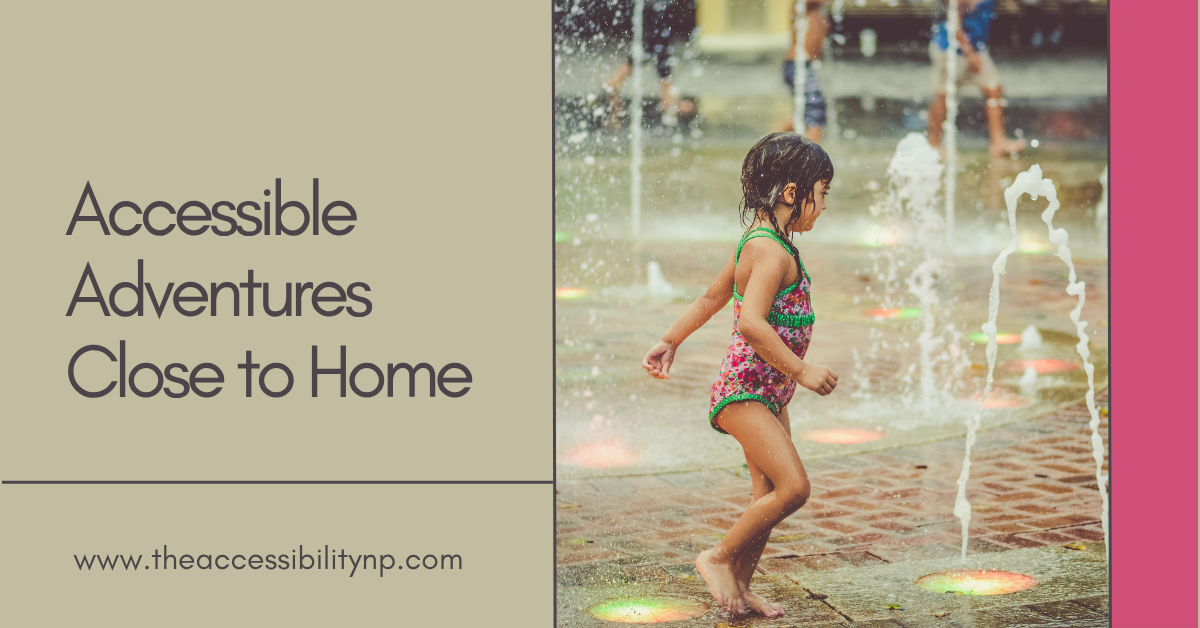Some families pack up for weeks at the beach. Others take cross-country flights, visit amusement parks, or spend days exploring crowded festivals. But for many of us raising disabled children, that version of summer just isn’t accessible—or sustainable.
And honestly? That’s okay.
This week, we’re talking about accessible adventures—not the kind that need a suitcase, but the kind that meet your child where they are. Adventures that honor their needs. That embrace flexibility. That bring joy without creating overwhelm.
Because inclusion doesn’t only live in destination getaways—it belongs in everyday places too.
Let go of the pressure to ‘go big’
If you’ve ever canceled an outing at the last minute, planned a trip around a bathroom you know they can use, or packed a bag with everything your child might need “just in case”… this is for you.
The world often makes us feel like summer has to be filled with big moments. But when accessibility is an everyday need, we learn how to celebrate small wins—10 minutes at the splash pad. A quiet hour at the library. A Target run that didn’t end in a meltdown.
That’s still summer. That’s still joy.
What makes an outing accessible?
For us, an outing is accessible when it allows our daughter to:
– Communicate in her own way
– Move her body safely and freely
– Take sensory breaks when needed
– Be supported without shame
– Leave early without guilt
It’s not about making the world perfect. It’s about making sure we don’t have to apologize for being who we are while we’re in it.
Accessible adventures we’ve loved
Sometimes the best experiences have been the ones we didn’t plan too tightly. Here are a few that worked well for our family:
Library visits during slow mornings, where she could explore without pressure. Splash pad outings before crowds arrived, letting her move freely and regulate in her own way. Drive-thru picnics where she could stay in the car with the windows down and stim as she pleased. Sidewalk scavenger hunts with chalk drawings or visual prompts that encouraged movement and language. Even short grocery store trips became valuable when she could participate and feel heard using her AAC.
These aren’t Instagram-perfect outings. But they’re ours—and they’re accessible.
Preparing for success (and what’s in the go-bag)
We don’t leave home without our go-bag. It’s not about overpacking—it’s about being ready to support our kids wherever they are. When outings feel unpredictable, having familiar items on hand brings stability, comfort, and peace of mind. It allows us to respond with care instead of scrambling in the moment.
Our go-bag gives us confidence. Whether we’re heading to the park, running errands, or just making a quick stop, we know we have what we need to support communication, regulation, and personal care. It’s not just practical—it’s a form of respect.
Every go-bag looks different, but here are some ideas to consider when building your own:
– Communication tools: AAC device, printed core board, mini whiteboard, or choice cards
– Sensory regulation items: headphones, sunglasses, something to squeeze, something to chew, or something to fidget with
– Comfort supports: a soft item, calming object, or something familiar from home
– Feeding essentials: snacks, preferred drinks, straws, utensils, anything that supports safe eating
– Personal care: wipes, extra clothes, pull-ups, tissues, period care items
– Medical needs: meds, emergency plan, or any item tied to their health and safety
– Visual supports: first/then cards, social story, or a mini schedule
– Other useful extras: charger, power bank, low-tech AAC backup, small towel, hand sanitizer
You might not need everything. You might swap things out week to week. But the idea is the same: to be prepared, to reduce stress, and to make space for your child to show up fully supported.
Sometimes you don’t realize what helps until you’re already out and need it. That’s why the go-bag matters. It doesn’t have to be fancy—it just needs to be yours. A small collection of things that say, “I see you. I’m ready.”
What’s really in that bag? Confidence. Dignity. A way to meet your child’s needs without having to explain or apologize.
When things don’t go as planned
Sometimes, even when we do everything “right,” an outing still ends in tears—hers or mine. And I’ve learned: that’s okay too.
We’ve walked out of events 15 minutes in. We’ve skipped a zoo trip we planned for weeks. We’ve left full carts at checkout. None of that makes the day a failure. It just means our child’s needs came first. That’s not failure. That’s parenting.
Inclusion means being expected
An accessible outing is one where we don’t feel like we’re “making it work”—but rather, we’re meant to be there.
That might mean a museum with sensory-friendly hours. A park with adaptive equipment. A church that doesn’t stare when your child flaps or vocalizes. A store with staff who kneel down and speak directly to your child—verbally or using gestures.
The most beautiful moments have come when we didn’t feel like visitors, but like participants.
Something to carry into the week
You don’t have to travel far to make memories that matter. Whether it’s bubbles in the backyard or a short ride around the block, what counts is how your child feels in the moment.
Safe. Seen. Supported.
Your summer adventure might not look like the one on social media. But if it includes access, connection, and a little laughter—then you’re doing it right.
Next week we’re slowing down to talk about rest—why it’s not optional, why it’s part of access, and how we make space for it even when everything feels nonstop.
Until then, take the trip—even if it’s just to the mailbox. And if you don’t? That’s okay too.

